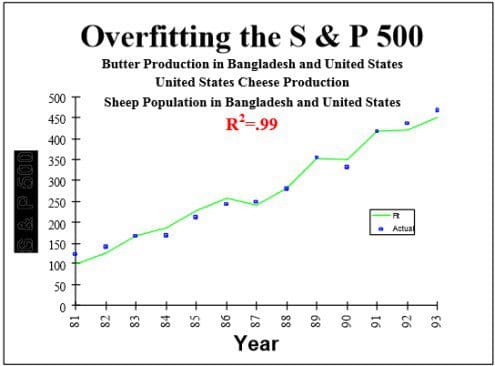Overfitting is the bane of Data Science in the age of Big Data. John Langford reviews "clever" methods of overfitting, including traditional, parameter tweak, brittle measures, bad statistics, human-loop overfitting, and gives suggestions and directions for avoiding overfitting.
 We should all be aware of these methods, avoid them where possible, and take them into account otherwise. I have used “reproblem” and “old datasets”, and may have participated in “overfitting by review”—some of these are very difficult to avoid. 1. Traditional overfitting: Train a complex predictor on too-few examples. Remedy:
We should all be aware of these methods, avoid them where possible, and take them into account otherwise. I have used “reproblem” and “old datasets”, and may have participated in “overfitting by review”—some of these are very difficult to avoid. 1. Traditional overfitting: Train a complex predictor on too-few examples. Remedy: - Hold out pristine examples for testing.
- Use a simpler predictor.
- Get more training examples.
- Integrate over many predictors.
- Reject papers which do this.
 Remedy: For example, take a time series dataset and use cross validation. Or, ignore asymmetric false positive/false negative costs. This can be completely unintentional, for example when someone uses an ill-specified UCI dataset. Remedy: Discount papers which do this. Make sure problem specifications are clear. 10. Old datasets: Create an algorithm for the purpose of improving performance on old datasets. After a dataset has been released, algorithms can be made to perform well on the dataset using a process of feedback design, indicating better performance than we might expect in the future. Some conferences have canonical datasets that have been used for a decade… Remedy: Prefer simplicity in algorithm design. Weight newer datasets higher in consideration. Making test examples not publicly available for datasets slows the feedback design process but does not eliminate it. 11. Overfitting by review: 10 people submit a paper to a conference. The one with the best result is accepted. This is a systemic problem which is very difficult to detect or eliminate. We want to prefer presentation of good results, but doing so can result in overfitting. Remedy:
Remedy: For example, take a time series dataset and use cross validation. Or, ignore asymmetric false positive/false negative costs. This can be completely unintentional, for example when someone uses an ill-specified UCI dataset. Remedy: Discount papers which do this. Make sure problem specifications are clear. 10. Old datasets: Create an algorithm for the purpose of improving performance on old datasets. After a dataset has been released, algorithms can be made to perform well on the dataset using a process of feedback design, indicating better performance than we might expect in the future. Some conferences have canonical datasets that have been used for a decade… Remedy: Prefer simplicity in algorithm design. Weight newer datasets higher in consideration. Making test examples not publicly available for datasets slows the feedback design process but does not eliminate it. 11. Overfitting by review: 10 people submit a paper to a conference. The one with the best result is accepted. This is a systemic problem which is very difficult to detect or eliminate. We want to prefer presentation of good results, but doing so can result in overfitting. Remedy: - Be more pessimistic of confidence statements by papers at high rejection rate conferences.
- Some people have advocated allowing the publishing of methods with poor performance. (I have doubts this would work.)
- Aleks Jakulin: How about an index of negative results in machine learning? There’s a Journal of Negative Results in other domains:, , and there is . A section on negative results in machine learning conferences? This kind of information is very useful in preventing people from taking pathways that lead nowhere: if one wants to classify an algorithm into good/bad, one certainly benefits from unexpectedly bad examples too, not just unexpectedly good examples.
- I visited the workshop on negative results at NIPS 2002. My impression was that it did not work well. The difficulty with negative results in machine learning is that they are too easy. For example, there are a plethora of ways to say that “learning is impossible (in the worst case)”. On the applied side, it’s still common for learning algorithms to not work on simple-seeming problems. In this situation, positive results (this works) are generally more valuable than negative results (this doesn’t work).
- What do you mean by “brittle”? Why is mutual information brittle?
- : What I mean by brittle: Suppose you have a box which takes some feature values as input and predicts some probability of label 1 as output. You are not allowed to open this box or determine how it works other than by this process of giving it inputs and observing outputs. Let x be an input.Let y be an output.Assume (x,y) are drawn from a fixed but unknown distribution D.Let p(x) be a prediction.For classification error I(|y – p(x)| < 0.5) you can prove a theorem of the rough form:for all D, with high probability over the draw of m examples independently from D, expected classification error rate of the box with respect to D is bounded by a function of the observations. What I mean by “brittle” is that no statement of this sort can be made for any unbounded loss (including log-loss which is integral to mutual information and entropy). You can of course open up the box and analyze its structure or make extra assumptions about D to get a similar but inherently more limited analysis. The situation with leave-one-out cross validation is not so bad, but it’s still pretty bad. In particular, there exists a very simple learning algorithm/problem pair with the property that the leave-one-out estimate has the variance and deviations of a single coin flip. Yoshua Bengio and Yves Grandvalet in fact proved that there is . The paper that I pointed to above shows that for K-fold cross validation on m examples, all moments of the deviations might only be as good as on a test set of size $m/K$. I’m not sure what a ‘valid summary’ is, but leave-one-out cross validation can not provide results I trust, because I know how to break it.I have personally observed people using leave-one-out cross validation with feature selection to quickly achieve a severe overfit.